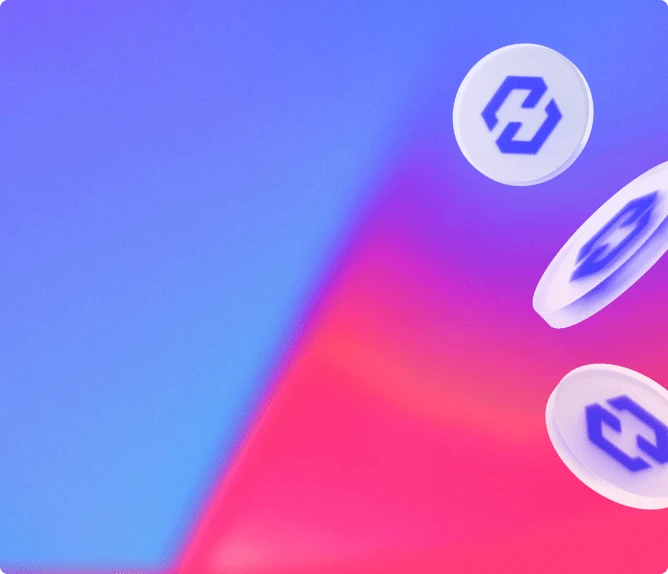Investing in crypto-assets carries risks of liquidity, volatility, and partial or total capital loss. Crypto-assets held are not covered by deposit and securities guarantee mechanisms.


Sign up for our newsletter
Partners
Coinhouse
Our accounts
Coinhouse
Coinhouse SAS with a capital of €210,000, RCS Paris 815 254 545, headquarters: 14 Avenue de l'Opéra 75001 Paris – support@coinhouse.com. Registered with the AMF for activities related to the purchase/sale of digital assets against legal tender, the exchange of digital assets for other digital assets, and the custody of digital assets for third parties under the registration number: E2020-001.
Coinhouse payment solutions
Company registered with the Paris RCS under the number 914 384 557, registered with the Prudential Control and Resolution Authority as a payment service agent under the number 727503 of the electronic money institution Treezor, headquartered at 33 Avenue de Wagram, 75017 Paris.
General conditions, disclaimers and legal documents.



Uniswap is a decentralized exchange platform for trading ERC-20 tokens on the Ethereum blockchain.
The platform enables users to trade crypto-assets without having to go through a centralized entity.
Since its launch in 2018, Uniswap has grown rapidly in terms of trading volume and adoption, making it one of the largest DeFi (decentralized finance) ecosystems to date.
This article takes a deep dive into the workings, benefits and challenges of Uniswap.
By 2023, Uniswap will be the undisputed leader in decentralized finance exchanges (DEX), in terms of volumes exchanged as well as Total Value Locked (TVL), i.e. funds under management by the platform.
It is also one of the leading projects in decentralized finance as a whole.
It is therefore essential to understand the ins and outs of this rich project.
The story behind the creation of Uniswap is quite interesting.
The protocol was created by Hayden Adams, a software engineer.
Hayden Adams was introduced to the concept of decentralized exchange and decentralized finance (DeFi) by Ethereum co-founder Vitalik Buterin.
Buterin even contributed to the initial idea by suggesting the use of an Automated Market Maker (AMM) model, an idea that was later integrated into the core Uniswap protocol.
Hayden Adams spent time studying smart contracts and working on the development of Uniswap.
His work was supported by a grant from the Ethereum Foundation, which enabled the project to take off without the need for traditional venture capital funding.
Ultimately, Uniswap was launched in November 2018.
The protocol quickly gained popularity in the DeFi community due to its simplicity and ease of use, becoming one of the most popular decentralized exchange platforms on the Ethereum blockchain.
Uniswap operates entirely on smart contracts on the Ethereum blockchain.
These smart contracts automate all interactions on the platform, eliminating the need for intermediaries and ensuring that all transactions are executed according to predefined rules.
This covers everything from the addition or withdrawal of liquidity in « Uniswap v3 pools », to the exchange of tokens between different users.
The smart contract code is open and transparent, enabling anyone to check how it works.
This reinforces confidence in the system, while enabling external verification to ensure that transactions are carried out securely and fairly.
The use of smart contracts also offers a major advantage in terms of interoperability and composability with other decentralized finance (DeFi) applications.
For example, a smart contract managing a loan could be configured to exchange assets automatically via Uniswap if certain conditions are met, all without human intervention.
This ability for different smart contracts and DeFi applications to interlock and work together seamlessly is often referred to as « money legos », and is one of the reasons why the DeFi ecosystem on Ethereum, with Uniswap as one of its pillars, is so dynamic and innovative.
But it’s not just Ethereum.
Uniswap has since been recreated on numerous Ethereum-based networks, such as Arbitrum, Polygon, Optimism(Optimism course), BSC, Avalanche (AVAX), Celo, or Base.
All these ports are easy to implement, as they are all natively compatible with the Ethereum blockchain.
Bear in mind, however, that there is no communication or transaction between the different Uniswaps, which operate on different networks.
But although Uniswap’s back-end runs entirely on smart contracts on the Ethereum blockchain, most users interact with the platform via a user-friendly web interface.
This interface acts as a kind of « window » into smart contracts, enabling users to carry out complex operations with just a few clicks.
Users typically connect to this interface using an Ethereum wallet such as MetaMask, WalletConnect or Coinbase Wallet.
Once connected, the wallet enables the user to sign transactions and interact directly with the smart contract, all without ever leaving the security of their wallet.
The importance of this web interface cannot be underestimated.
Although smart contracts offer remarkable transparency and security, they are not particularly easy for the general public to use without a well-designed user interface.
On Uniswap, it’s possible to trade a variety of tokens based on ERC-20, the most widely used standard on the Ethereum blockchain.
This covers a wide range of assets, from well-known cryptos such as Ether (ETH), Chainlink (LINK) or USDC, to tokens from more specialized or new projects.
The advantage of Uniswap is that anyone can create an exchange pair for any ERC-20 tokens, making the platform extremely flexible.
However, this also means that it is possible to find tokens on Uniswap that do not correspond to serious projects, as there is no curation of content.
One of the most significant advantages of Uniswap is its decentralized nature, unlike centralized exchanges, which are managed by a single entity.
This eliminates single points of failure and reduces the risk of censorship, asset seizure or service interruption.
All transactions and liquidity pools are recorded on the blockchain, offering complete transparency.
Users can verify all transactions without relying on a trusted third party.
In a centralized exchange, users have to deposit their funds, which implies a security risk.
Uniswap eliminates the need for custodians by allowing users to retain control of their private keys – and, by extension, their assets – at all times.
Uniswap enables a degree of anonymity that is generally difficult to maintain on centralized exchanges, which often have strict know-your-customer (KYC) and anti-money-laundering (AML) requirements.
Commissions on Uniswap are very low, and depend on the asset pairs considered.
In general, the lower the volatility between the two assets, the lower the commission.
For example, on a USDT/USDC pair, commissions will be in the region of 0.1%, while on a pair between two little-known assets they could be as high as 1%.
As a reminder,USDT is a stablecoin.
Trading volumes can have a significant impact on both Automated Market Maker (AMM) and Uniswap prices.
In the AMM model, each transaction immediately affects the price of a pair of tokens by modifying the quantities of each token in the liquidity pool.
The larger the transaction relative to the size of the pool, the greater the impact on price.
This phenomenon is often referred to as « slippage » in the jargon of decentralized finance.
Slippage is generally higher in pools with less liquidity and for larger trades.
Many traders take potential slippage into account when assessing the efficiency of a Uniswap trade, especially if large volumes are involved.
Conversely, a trade that rebalances the liquidity pool will be cheaper for the user.
The concept of the liquidity provider is central to decentralized exchange platforms (DEX) that use Automated Market Maker (AMM) models, such as Uniswap.
Liquidity providers play an essential role in the operation and success of these platforms.
In a traditional centralized exchange, buyers and sellers place orders to buy or sell assets.
In a DEX with an AMM, there is no order book.
Instead, liquidity pools are created for each pair of tokens.
These pools function as pools of assets from which traders draw to buy or sell.
Liquidity providers are the participants who deposit assets in these pools.
For example, if you are a liquidity provider for an ETH/USDC pair, you deposit an equivalent quantity of each token into the pool.
These deposits are used to facilitate trading between the two assets.
In exchange for their contribution to the pool, liquidity providers receive remuneration in the form of transaction fees generated from trades that use their liquidity.
On Uniswap V2, these fees average 0.3% per transaction, divided between all liquidity providers according to their share of the pool.
Becoming a liquidity provider is not without risks.
One of the main risks is the so-called « impermanent loss ».
This phenomenon can occur when the prices of tokens in a liquidity pool change from the time they were deposited.
If prices change significantly, the value of the tokens deposited by the liquidity provider may lose value, whereas if these tokens had been held in a portfolio, they would have retained their value.
When a liquidity provider adds funds to a pool, it receives « liquidity tokens » in return.
These tokens represent their share of the pool, and can be used to claim their share of assets and transaction fees at any time.
With Uniswap V3, liquidity providers have more control over the price ranges for which they provide liquidity.
This enables them to tailor their risk and return to their own investment strategies.
Liquidity providers facilitate a healthy ecosystem for DEX by providing the necessary resources for trading.
The more liquidity there is, the less slippage there is on trades, making the platform more attractive to traders.
In short, liquidity providers play a key role in the performance and stability of DEXs like Uniswap.
In return for the liquidity they provide, they have the opportunity to earn transaction fees, although they are also subject to certain risks, notably that of impermanent loss.
The UNI token is the governance token for the Uniswap decentralized exchange platform.
Launched in September 2020, this token enables holders to participate in decisions concerning the development and operation of the platform.
The main advantage of the UNI token is that it gives holders the power to propose and vote on changes to the Uniswap protocol.
This includes changes to transaction fees, the introduction of new features, and other aspects of the platform’s governance and development.
Token holders can delegate their voting rights to others if they wish.
At launch, a significant number of UNI tokens were distributed to existing Uniswap users and liquidity providers, as part of an airdrop.
This gesture was widely hailed as a fair way of distributing governance power to the users who had contributed to the platform’s initial success.
UNI token holders also have the opportunity to participate in various compensation programs.
For example, they can deposit their UNIs in liquidity pools to earn transaction fees or other rewards.
The UNI token was introduced in September 2020, with an initial allocation of 1 billion tokens, to be issued over a four-year period.
60% of the total token offering has been allocated to members of the Uniswap community, including liquidity providers and users.
21.51% was reserved for the team and founders, with a vesting period of 4 years.
0.69% was reserved for advisors, with a similar vesting period.
The remaining 17.8% was earmarked for community development, educational initiatives and more.
The UNI token is also used to encourage liquidity providers to deposit their tokens in Uniswap’s liquidity pools.
In return, they receive transaction fees and rewards in UNI tokens.
Uniswap represents a major innovation in the crypto exchange landscape, offering a decentralized alternative to traditional centralized platforms.
Thanks to its intelligent use of smart contracts and its AMM model, Uniswap has succeeded in solving key problems linked to liquidity and accessibility, while making governance more participative thanks to its UNI token.
Like any technology, Uniswap is not static.
Updates to the protocol, such as Uniswap V3, introduce new features and changes that can have a significant impact on users and liquidity providers.
The latest feature implemented on Uniswap is NFT trading.
In this way, the platform adapts to market developments to meet user demand.
In a rapidly evolving market where interest in decentralized assets continues to grow, Uniswap
occupies a unique position. It is both a facilitator of the growing DeFi ecosystem and an example of how decentralization can transform sectors traditionally dominated by centralized entities. As the platform continues to develop and adapt, it should remain a key player in the future of decentralized finance. Uniswap is much more than a simple token exchange tool: it is an essential component of the infrastructure of decentralized finance, offering possibilities far beyond simple transactions and paving the way for a more open, inclusive and resilient financial system.
Share the article


Download app